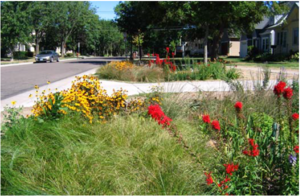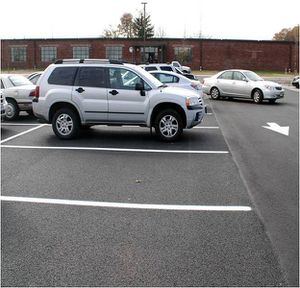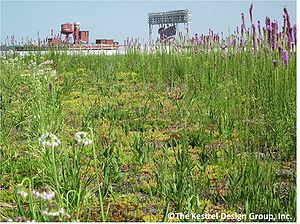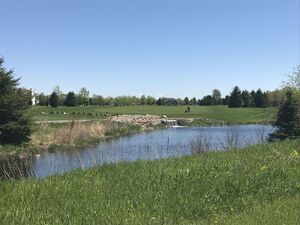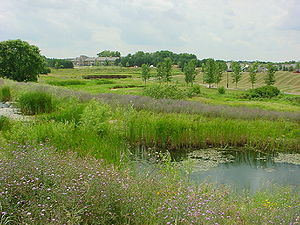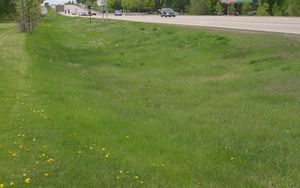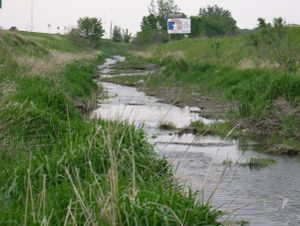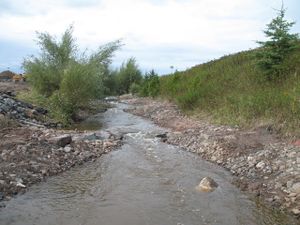
Water quantity and hydrology benefits of Green Stormwater Infrastructure
This page provides information on the water quantity and hydrology benefits of green stormwater infrastructure (GSI) practices ( best management practices or bmps). The water quantity benefit of a practice is defined by its ability to retain runoff or detain and slowly release runoff. These benefits include the following.
- Decreased downstream flooding as water is either captured or slowly released to reduce peak runoff volumes (rate control). These reductions in downstream runoff volume also reduce impacts to receiving waters by reducing erosion and protecting habitat.
- Increased groundwater recharge, which can lead to improved baseflow and deep aquifer recharge
- Reductions in downstream runoff volumes also provide additional benefits, such as reduced erosion.
Water quantity benefits vary between each practice, primarily as a result of the mechanism by which stormwater runoff is captured and by its ultimate fate.
- Constructed ponds ( wet ponds) and wetlands ( stormwater wetlands) temporarily capture and store water, releasing it slowly. This decreases peak discharges downstream. There is some water loss through seepage and e evapotranspiration, but these losses are considered negligible. See Calculating credits for stormwater ponds. For more information on sedimentation processes, link here.
- Filtration practices include bmps that have an underdrain ( biofiltration, permeable pavement, tree trench, swales, green roofs, and media filters) or bmps that provide some water retention in soil or engineered media ( vegetated filter strips, swales, green roofs). In practices with underdrains, there is always some infiltration below the underdrain, provided the practice does not have an impermeable liner. The annual volume lost depends on the position of the underdrain and the infiltration characteristics of the underlying soil. In vegetated practices with underdrains, there is also water loss through evapotranspiration. Annual losses in these practices are typically in the 5 to 20 percent range. Green roofs are effective at retaining water, while volume reduction in swales and filter strips is generally small.
- Infiltration practices retain all water captured by the practice. This captured water is infiltrated through the soil, vadose zone, and into groundwater.
| Practice | Water quanity benefit | Notes |
|---|---|---|
| Bioretention | Benefit is high for infiltration, low for filtration | |
| Tree trench and tree box | Benefit is high for infiltration, low to moderate for filtration | |
| Green roof | Benefit is associated with rate control; effectiveness increases with media thickness | |
| Vegetated swale | Benefit is high for infiltration, low for filtration | |
| Vegetated filter strip | ||
| Permeable pavement | Benefit is high for infiltration, low for filtration | |
| Constructed wetland | Benefit is associated with rate control | |
| Rainwater harvesting | Can be used on low permeability soils | |
| Level of benefit: ◯ - none; ◔; - small; ◑ - moderate; ◕ - large; ● - very high | ||
Contents
Green infrastructure and multiple benefits
Green infrastructure (GI) encompasses a wide array of practices, including stormwater management. Green stormwater infrastructure (GSI) encompasses a variety of practices primarily designed for managing stormwater runoff but that provide additional benefits such as habitat or aesthetic value.
There is no universal definition of GI or GSI (link here for more information). Consequently, the terms are often interchanged, leading to confusion and misinterpretation. GSI practices are designed to function as stormwater practices first (e.g. flood control, treatment of runoff, volume control), but they can provide additional benefits. Though designed for stormwater function, GSI practices, where appropriate, should be designed to deliver multiple benefits (often termed "multiple stacked benefits". For more information on green infrastructure, ecosystem services, and sustainability, link to Multiple benefits of green infrastructure and role of green infrastructure in sustainability and ecosystem services.
Bioretention
Bioretention can be designed as an effective infiltration / recharge practice ( bioinfiltration) when parent soils have high permeability. For lower permeability soils an underdrain is typically used and some infiltration and rate control can be achieved.
Bioinfiltration practices, which are bioretention practices with no underdrain and designed to infiltrate water, are effective at reducing runoff volume and peak rates for small and medium intensity storms. A bioinfiltration practice designed to capture 1 inch of runoff from a 2 acre site consisting of 1 acre of impermeable surface and 1 acre of turf on hydrologic soil group B soils, for example, will capture about 90 percent of annual runoff.
Effects of bioinfiltration on groundwater hydrology are poorly understood. It is often assumed increased recharge will result in increased aquifer recharge and/or increased baseflow to surface waters, but limited data exists to support these assumptions.
The following design considerations can increase the water quantity/hydrologic benefits of bioretention practices.
- Maximize infiltration through sizing and identifying the most permeable soils on a site
- Utilize internal water storage
- Maximize water storage in engineered media
- Bioinfiltration practices scattered throughout a watershed can reduce runoff volumes and peak runoff
See Calculating credits for bioretention and Hunt et al (2009; 2012).
Tree Trench
Tree trenches are a type of bioretention practice. However, their potential benefits for water quantity and hydrology are greater than for traditional bioretention practices due to their ability to treat runoff from larger areas, hence more runoff volume, because of the enhanced evapotranspiration provided by trees, and due to interception of rainfall by tree canopies. On higher permeability soils they can be designed as infiltration practices, while on lower permeability soils they typically have an underdrain.
Tree trenches with no underdrain are effective at reducing runoff volume and peak rates for small and medium intensity storms. A bioinfiltration practice designed to capture 1 inch of runoff from a 2 acre site consisting of 1 acre of impermeable surface and 1 acre of turf on B soils, for example, will capture about 90 percent of annual runoff.
Reduction in runoff due to trees is highly variable and depends on many factors such as, but not limited to, tree characteristics, planting configuration, soil conditions, and precipitation event characteristics. For examples, studies show that annual rainfall interception by urban trees and forests can range from 6% to 66%, while urban trees can transpire from 0.2 to 46.7 gallons per tree per day (Center for Watershed Protection, 2005).
The following design considerations may increase the water quantity and hydrology benefits of tree-based practices.
- Maximize infiltration by designing larger practices, if feasible, and identifying the most permeable soils on a site
- Utilize internal water storage
- Maximize water storage in media
- Select species appropriate for the local current and future water conditions, which typically combine high rates of biomass accumulation with high evapotranspiration.
See Calculating credits for tree trenches and tree boxes
Permeable pavement
Permeable pavement provides reduction in total water volume movement and retardation of peak flow from rainfall events. When constructed without an underdrain (as an infiltration practice), they provide significant volume reduction if properly maintained, though they are typically small in size and therefore treat runoff from limited areas. When an underdrain is incorporated into the design, they provide rate control by temporarily storing and infiltrating water before the water is captured by the underdrain.
Permeable pavement can be used in conjunction with other GSI practices, such as bioretention and harvest and reuse systems.
The following design consideration may increase the water quantity and hydrology benefits of permeable pavement practices.
- Ensure the subgrade is flat. Since roads are typically sloped, utilize terracing in the subgrade to achieve flat slopes. See page 5 of the North Carolina design guidance.
- Incorporate signage into the design to ensure maintenance activities do not affect the infiltration properties of the pavement.
- Design to maximize retention time and prevent short-circuiting. Storage may be increased by use of geotextile subgrades. An example is presented by Nnadi et al, (2014).
- Plan for the expected loading on the permeable pavement and ensure capabilities and reduce compaction or clogging
- Use in conjunction with other treatments to establish a treatment train or reuse water on site
See Calculating credits for permeable pavement
Green Roofs
Green roofs have the ability to store significant amounts of water in their growing media. Water can evaporate from the soil and be transpired by the vegetation and plants growing in the media. As a result, runoff from the roof is reduced which decreases flow to storm sewer systems and can ultimately reduce overflow events and flooding events. This can be beneficial especially in highly developed urban areas where stormwater is conveyed to storm sewer systems that can frequently experience combined sewer overflows.
The selection of growth medium, thickness of the growth medium, plant species, and roof slope can have a significant effects on the effectiveness and performance of a green roof for hydrologic purposes. Green roofs can generally be categorized as either intensive or extensive. Intensive roofs have a soil depth of 6 inches or greater, whereas extensive roofs have less than 6 inches of soil depth (Carpenter, 2016).
The following design considerations may increase the water quantity and hydrologic benefits of green roofs.
- Increase media depth to extent economically feasible
- Maximize the sorptive and retention properties of the media. Increasing the organic fraction can increase water retention but may result in phosphorus export and other concerns if drying occurs. Additives such as perlite and pumice increase water retention. See Bollman et al., 2019)
- Select plants with high evapotranspiration rates, keeping mind the harshness of green roof microclimates
- Combine green roofs with other treatment practices, such as harvest and reuse systems and roof disconnection
See Calculating credits for green roofs
Water Re-use and Harvesting
Water re-use and harvesting systems help capture rainfall and minimize stormwater runoff volumes and rates to receiving stormwater sewer systems and conveyances. Harvest and reuse systems capture water and increase a user’s water supply that can be stored and used on site, immediately or in the future, in lieu of the local water supply, including use of potable water. This can be particularly advantageous in times of droughts when water may not be readily available. These systems also help alleviate pressure on the local water supply and allows communities to allocate water to other users. Reusing rainwater for irrigation purposes can also help increase groundwater recharge.
The potential benefits delivered by a harvest and reuse system depend on the type of system. Practices utilizing storage tanks typically have limited storage capacity and are used for site applications. Constructed ponds and wetlands have much greater storage capacity and can be used in larger applications. See Design considerations for constructed stormwater ponds used for harvest and irrigation use/reuse.
The following design considerations may increase the potential water quantity and hydrology benefits of harvest and reuse systems.
- Consider using harvesting on low permeability soils ( hydrologic soil group C and D soils), where captured water can be distributed through irrigation and/or used indoors.
- Size the system to meet the intended uses of the harvest system. This includes ensuring appropriate water supply in response to demand. See Determining the appropriate storage size for a stormwater and rainwater harvest and use/reuse system and Design criteria for stormwater and rainwater harvest and use/reuse.
- Construct the distribution system to reach all areas of the site that require water when economically feasible
- Determine the sites’ water needs for vegetation and plant systems over a given time period and design the water storage container to meet these needs. Typically, harvest systems are designed and built with a specific use and vegetation scheme in mind, but if feasible, consider adopting vegetation to an intended harvest system (i.e. if the objective is driven by performance goals for the harvest system, vegetation considerations should be built into the design considerations).
- Utilize tandem systems which combine multiple storage units, such as multiple rain barrels in sequence (Kwiatkowski, 2012)
- Determine the feasibility of distributed systems, which employs a combination of residential (parcel) harvesting, neighborhood harvesting, and regional harvesting, matching the system to the appropriate storage capacity (Nguyen et al., 2022).
See Calculating credits for stormwater and rainwater harvest and use/reuse
Constructed ponds and wetlands
Constructed ponds and wetlands capture stormwater runoff and slowly release the runoff, thus decreasing peak flows downstream of the practice. Although there may be some seepage through the bottom of the pond or wetland, and some evaporative loss, these losses are negligible. The primary benefit of these practices is therefore on rate control, which can reduce downstream flood impacts. Wet ponds and wetlands can be designed to capture runoff from large areas, thus making these practices potentially effective over large areas.
The following design considerations may increase the water quantity and hydrologic benefit of constructed ponds and wetlands.
- Distribute constructed wetlands systemically throughout a watershed to increase potential for delivering networked benefits
- Utilize the practice for reuse purposes, which allows for increased storage
Swale with Check Dam (with and without underdrain)
The water quantity and hydrologic benefits of swales depends on the type of swale and the presence or absence of impermeable check dams. Swales without check dams convey stormwater and therefore provide limited hydrologic benefit, though on flatter slopes they provide some rate control.
- Impermeable check dams can be employed for dry swales and stormwater step pools on permeable soils. Water stored behind the check dams will infiltrate into the underlying soil.
- On soils with lower permeability, permeable check dams may be employed to slow water movement and provide some rate control
- Some infiltration may occur on permeable soils when check dams are not employed
The following design considerations may potentially increase the water quantity and hydrologic benefits of swales.
- If underlying soils are permeable, incorporate impermeable check dams into the design to promote infiltration.
- For wet swales incorporate permeable check dams to slow water movement (rate control)
- Engineered media may be used in some designs to increase water storage. This stored water may infiltrate or be utilized by plants.
See Calculating credits for dry swale (grass swale), Calculating credits for high-gradient stormwater step-pool swale, and Calculating credits for wet swale (wetland channel)
Additional recommended reading
- Field Performance of Bioretention: Hydrology Impacts
- Bioretention Hydrologic Performance in an Urban Stormwater Network
- Meeting Hydrologic and Water Quality Goals through Targeted Bioretention Design
- Mitigation of Impervious Surface Hydrology Using Bioretention in North Carolina and Maryland
- Spatio-temporal effects of low impact development practices
- Water Recycling and Re-use: The Environmental Benefits
- Rainwater Harvesting
- Hydrologic and Water Quality Evaluation of a Permeable Pavement and Biofiltration Device in Series
References
- Bollman, M.A., G.E. DeSantis, R.M. DuChanois, M. Etten-Bohm, D.M. Olszyk, J.G. Lambrinos, P.M. Mayera. 2019. A framework for optimizing hydrologic performance of green roof media. Ecol Eng. 140:1–105589. doi: 10.1016/j.ecoleng.2019.105589.
- Carpenter, D. 2016. Hydrologic Design of Vegetated Roofs. 20 June 2016 MWEA Annual Conference.
- Center for Watershed Protection. 2017. Runoff Rundown. ISSUE 66, JANUARY 2017.
- Center for Watershed Protection. 2005. URBAN WATERSHED FORESTRY MANUAL Part 2: Conserving and Planting Trees at Development Sites
- Hunt, W.F. and W.G. Lord. 2006. Bioretention Performance, Design, and Construction and Maintenance. North Carolina Cooperative Extension Service.
- Hunt, W., Davis, A., and Traver, R. 2012. Meeting Hydrologic and Water Quality Goals through Targeted Bioretention Design. J. Environ. Eng., 138(6), 698–707. doi: 10.1061/(ASCE)`EE.1943-7870.0000504
- Kwiatkowski, P. 2012. Rainwater Harvesting: A Simple Approach to Conservation. Ecological Landscape Alliance.
- Nnadi, E.O., S.J. Coupe, L.A. Sañudo-Fontaneda, and J. Rodriguez-Hernandez. 2014. An evaluation of enhanced geotextile layer in permeable pavement to improve stormwater infiltration and attenuation. International Journal of Pavement Engineering, Volume 15, - Issue 10.
- Nguyen, T.T., P.M. Bach, and M. Pahlow. 2022. Multi-scale stormwater harvesting to enhance urban resilience to climate change impacts and natural disasters. Blue-green Systems, Volume 4, Issue 1.
- Selbig, W.R. 2019. Evaluating the potential benefits of permeable pavement on the quantity and quality of stormwater runoff. United States Geological Survey.
- Yanling, L., R.W. Babcock Jr. 2014. Green roof hydrologic performance and modeling: a review Water Sci Technol., 69(4):727-38. doi: 10.2166/wst.2013.770.
This page was last edited on 16 February 2023, at 22:10.


